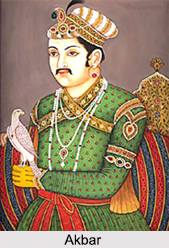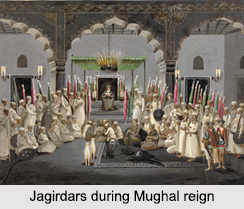 Jagir system during Mughal Empire was considered as an institution that was mainly used to reserve the surplus from the class of peasants. Further, jagir system was also used in order to distribute the income resources among the dominating classes. This system became all-pervasive and was the institution of month-scales or ratios. This seems to have arisen out of the discrepancy between the official assessment of jagir (jama) and the actual revenue collection (basil).
Jagir system during Mughal Empire was considered as an institution that was mainly used to reserve the surplus from the class of peasants. Further, jagir system was also used in order to distribute the income resources among the dominating classes. This system became all-pervasive and was the institution of month-scales or ratios. This seems to have arisen out of the discrepancy between the official assessment of jagir (jama) and the actual revenue collection (basil).
Origin and Connotation of Jagirdar System
The term Jagirdar System was derived by combining two Persian words: "Jagir" (which means holding land) and "dar" (which means official). A Jagir is basically a type of a feudal territory which a ruler grants to an army chieftain in lieu of recognition of his military service. This system was started in the 13th Century. At that time, the power to collect tax from a particular estate was accorded to an appointee of the state. Granting land to an individual for the purpose of collection of revenue in lieu of cash salary is an age-old practice in India. During the Delhi Sultanate reign, such land grants were called Iqtas and the holders, Iqtadars. The Mughals also started practicing this system and during their reign, the lands granted were called Jagirs and their holders, Jagirdars. It is worth mentioning in this connection that it is not land that was assigned but the right to collect revenue from the piece of land.
Generally, there were two forms of Jagir; Conditional Jagir and Unconditional Jagir. Conditional Jagir means that the governing family to whom the land was granted had to provide service to the State as and when it was necessary. The family had to maintain troops. The land was usually made for life, and the rule was that the Jagir would revert to the state on the occasion of death of the holder. However, it was possible for the heir to renew it with a fee.
History of Jagir System
The Jagir system was adapted by the Delhi Sultanate, from an already existing agricultural system. This system was entirely feudalistic, and carried tendencies to weaken the governing body of the state. The practice of the Jagir system was slowed down by Sultan Ghiyas al-Din and was abolished during the reign of Alauddin Khilji. However, it was again revived by Sultan Firuz Shah Tughluq. The early Mughal emperors wanted to amend the system by preferring to reward the officials with cash salaries. However, the later Mughal emperors reintroduced the same old system.
 During the reign of Akbar, the territory was divided into Khalisa and Jagir. The Mughal Jagirdari system basically began during Akbar"s reign and as mentioned earlier, in course of time it underwent few modifications. The Jagirdari system was created by Akbar to consolidate and expand his empire. This system embraced both civil and military sectors of adminis¬tration. During the reign of Babur and Humayun, revenues were collected from the assigned territories through Wajahdars by fixing "wajah".
During the reign of Akbar, the territory was divided into Khalisa and Jagir. The Mughal Jagirdari system basically began during Akbar"s reign and as mentioned earlier, in course of time it underwent few modifications. The Jagirdari system was created by Akbar to consolidate and expand his empire. This system embraced both civil and military sectors of adminis¬tration. During the reign of Babur and Humayun, revenues were collected from the assigned territories through Wajahdars by fixing "wajah".
Features of Jagir System
Under the Jagir system, the Jagirdar collected taxes which at the same time paid his salary. The rest of the revenue was deposited to the Mughal treasury. Generally, the revenue generated from the Khalisa territory was deposited in the imperial treasury. The assigning of the task of revenue collection was mostly dependent on the rank of the Jagirdar. The Mansabdars were thus granted maximum territory. "Jama Ojamadari" is a term that was used to denote the estimated revenue from the territory. When a man obtained a jagir whose Jama (sum of saved money) equalled his annual salary-claim (Talab) on paper, he might in actual fact find it yielding him only one-half or one-fourth of his claim. In such cases, the jagir was supposedly known as "Shash maha" (six monthly) or "Sib Maha" (three monthly) respectively. The Jama Ojamadari was calculated in "Dam", a small copper coin. The Jama also included land revenue, port customs and other taxes etc.
In practice, there were various types of Jagirs, they included Jagir Tankha (Jagirs given in lieu of pay), Mashrut Jagirs (Conditional Jagir), Inam Jagirs (those which had no obligations of service and which were independent of rank), and Watan Jagirs ( Jagirs which were granted Zamindars in their home lands). The grant of the Jagir got reverted to the state upon the Jagirdar"s death. However, with time, Jagirs became hereditary and got transferred to the male heir of the Jagirdar. The Jagirdars did not work alone, but recruited for several administrative positions for the work of revenue collection. Patwari, Tahsildar, Amil, Fotedar, Diwan being some of the positions.
The Jagirdars could practice no corruption and were allowed to collect only the amount decided and fixed by the emperor. There would be a smooth functioning imperial bureaucracy for keeping a strict watch over the Jagirdars. They were penalized if any situation of harassment of the peasants for excess payments came into being. In fact, during Akbar"s reign an "Amir" was appointed in the Suba to see whether the Jagirdars implemented the royal orders or not.
Jagir System under the Mughal Rulers
As mentioned above, during the Mughal rule, the revenue earned from Jagir was assigned to Jagirdars as per their ranks in place of their salary in cash or Naqad. Some of them were given both cash as well as Jagir. During the later years of Shah Jahan the actual Basil of the Mughal Deccan amounted to approximately one quarter of the Jama (that is equal to three months only). The Jagirs of most Mansabdars in the Deccan were not more than four-monthly and often they were even less. Conditions however appeared to have been better in northern parts of India. In the later years of Shah Jahan and during the reign of Aurangzeb, complaints were heard that a transfer from northern India to the Deccan entailed Jagir on a lower monthly-scale. The monthly Jagir system of Mughal Dynasty was applied also to cash salaries.
 One of the main features of Jagir system during the Mughal era was the changing of Jagir holders from one to another, for administrative reasons. In the case of the Basil, realized from his Jagir by an assignee, the proportion it bore to the jama would of course, only correspond with the exact proportion of month-scale.
One of the main features of Jagir system during the Mughal era was the changing of Jagir holders from one to another, for administrative reasons. In the case of the Basil, realized from his Jagir by an assignee, the proportion it bore to the jama would of course, only correspond with the exact proportion of month-scale.
Jagir system of Mughal Empire wholly pivoted around the father-son duo, Shah Jahan and Aurangzeb, standing at opposing poles. The pay schedule from 12 to 7 months, however, came to be merely of academic interest, since Aurangzeb decided in his 21st year of reign, to lower Shah Jahan`s maximum allowance from 8 months to 6 months. As against the sanctioned claim, there used to be a number of deductions in the pay schedules. The dissimilarities between the Mughals and Maratha warriors manifested wholly in the Jagir system, with other principles also thrown in. Jagir system under the later Mughal rulers began to be tightened, with the Jagirdars suffering the most. There was another deduction in pay scale. This was technically known as "Irmas". According to historians, this was a synonym for Talab-i-Ijnas (or demand for supplies). It should be mentioned that Akbar had been quite compassionate towards the Jagir system of Mughal Empire, entrusting Jagirdars with unusual payments.
The salaries payable to Sawars were gradually reduced from the time of Akbar to the time of Shah Jahan and Aurangzeb. This reduction did not, however, have much direct impact upon the income of the nobles themselves, owing to the reduction in their military obligations. The introduction of the month-scales during the times of Shah Jahan, on the other hand, had a direct impact on the pay scales of the nobles. Since it had become usual in the time of Aurangzeb to assign Jagirs on a scale not higher than a six-month one, the reduction in salaries was fairly considerable.
There also existed fines or "Jurmana" for Jagirdari system during Mughal Empire. These were imposed predominantly for deficiencies in the contingents required from the nobles. During Aurangzeb`s reign, the conditions changed. The officers did not receive Jagirs for long periods and so their claims went on hoarding up. This was yet another shrewd device by which Jagir system during Mughal Empire looked towards greener pastures, or a better system which would reimburse required expenses.
Decline of the Jagir System
The Jagir system being feudalistic in character eventually started to weaken the Mughal State. After the collapse of the Mughal Empire, which happened for several other reasons alongside, the Jagirdar system was retained by Rajput, Saini and the Sikh Jat kingdoms and later, by the British East India Company. The East India Company was given a Jagir by Nawab Muhammad Ali of Arcot in present-day Tamil Nadu. During the colonial British Raj, most princely states of India were Jagirdars. Being an impractical and feudalistic system, it hampered the proper functioning of the state during the British rule as well. Also there were cases of harassment of peasants by the British officials. Shortly following independence from the British Crown in 1947, the jagirdar system was abolished by the Indian government in 1951.



















